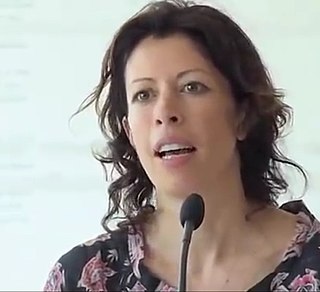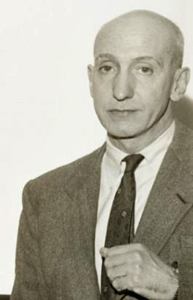Related Research Articles

Mark Rothko, born Markus Yakovlevich Rothkowitz, was a Latvian-born American abstract painter. He is best known for his color field paintings that depicted irregular and painterly rectangular regions of color, which he produced from 1949 to 1970. Although Rothko did not personally subscribe to any one school, he is associated with the American Abstract Expressionist movement of modern art.
Abstract Expressionism in the United States emerged as a distinct art movement in the immediate aftermath of World War II and gained mainstream acceptance in the 1950s, a shift from the American social realism of the 1930s influenced by the Great Depression and Mexican muralists. The term was first applied to American art in 1946 by the art critic Robert Coates. Key figures in the New York School, which was the epicenter of this movement, included such artists as Jackson Pollock, Franz Kline, Mark Rothko, Norman Lewis, and Willem de Kooning, among others.

Clyfford Still was an American painter, and one of the leading figures in the first generation of Abstract Expressionists, who developed a new, powerful approach to painting in the years immediately following World War II. Still has been credited with laying the groundwork for the movement, as his shift from representational to abstract painting occurred between 1938 and 1942, earlier than his colleagues like Jackson Pollock and Mark Rothko, who continued to paint in figurative-surrealist styles well into the 1940s.

Lenore "Lee" Krasner was an American Abstract Expressionist painter and visual artist active primarily in New York. She received her early academic training at the Women's Art School of Cooper Union, and the National Academy of Design from 1928 to 1932. Krasner's exposure to Post-Impressionism at the newly opened Museum of Modern Art in 1929 led to a sustained interest in modern art. In 1937, she enrolled in classes taught by Hans Hofmann, which led her to integrate influences of Cubism into her paintings. During the Great Depression, Krasner joined the Works Progress Administration's Federal Art Project, transitioning to war propaganda artworks during the War Services era.
Robert Motherwell was an American abstract expressionist painter, printmaker, and editor of The Dada Painters and Poets: an Anthology. He was one of the youngest of the New York School, which also included Willem de Kooning, Jackson Pollock, and Mark Rothko.

Adolph Gottlieb was an American abstract expressionist painter, sculptor and printmaker.

Cecily Brown is a British painter. Her style displays the influence of a variety of contemporary painters, from Willem de Kooning, Francis Bacon and Joan Mitchell, to Old Masters like Rubens, Poussin and Goya. Brown lives and works in New York.
Gabriel Laderman was a New York painter and an early and important exponent of the Figurative revival of the 1950s and 1960s.

Betty Parsons was an American artist, art dealer, and collector known for her early promotion of Abstract Expressionism. She is regarded as one of the most influential and dynamic figures of the American avant-garde.
Alfred Julio Jensen was an abstract painter. His paintings are often characterized by grids of brightly colored triangles, circles or squares, painted in thick impasto. Conveying a complex web of ideas, often incorporating calligraphy or numerical systems, they are frequently referred to as "concrete" abstract art. After his death in 1981, the Guggenheim organized a major retrospective of his work, having held his solo exhibition there in 1961.

Katherine Bradford, née Houston, is an American artist based in New York City, known for figurative paintings, particularly of swimmers, that critics describe as simultaneously representational, abstract and metaphorical. She began her art career relatively late and has received her widest recognition in her seventies. Critic John Yau characterizes her work as independent of canon or genre dictates, open-ended in terms of process, and quirky in its humor and interior logic.
Robert Beauchamp was an American figurative painter and arts educator. Beauchamp's paintings and drawings are known for depicting dramatic creatures and figures with expressionistic colors. His work was described in the New York Times as being "both frightening and amusing,". He was a Guggenheim Fellow and a student of Hans Hofmann.
Lila Katzen, born Lila Pell, was an American sculptor of fluid, large-scale metal abstractions.
Susan Sills is an American artist involved in the international art scene since the early 1990s. Although she has created abstract ink drawings and painted commissioned portraits, Sills is best known for her life-size painted wood cutouts based on the Old Masters. Sills has produced over 100 different wood cutouts, and finds innovative ways to bring these well-known icons of art into the present day. Her work is found in collections in Japan, New York City, and throughout the United States. Sills has had 20 solo exhibitions and participated in numerous group shows. Sills is based in Brooklyn, New York.

Karl Knaths was an American artist whose personal approach to the Cubist aesthetic led him to create paintings that, while abstract, contained readily identifiable subjects. In addition to the Cubist painters, his work shows influence by Paul Cézanne, Wassily Kandinsky, Utagawa Kuniyoshi, Paul Klee, Stuart Davis, and Agnes Weinrich. It is nonetheless, in use of heavy line, rendering of depth, disciplined treatment of color, and architecture of planes, distinctly his own.

George McNeil was an American abstract expressionist painter.

Agnes Weinrich was an American visual artist. In the early twentieth century, she played a critical role in introducing cubist theory to American artists, collectors, and the general public and became one of the first American abstractionists. A life-long proponent of modernist art, she was an active participant in the art communities of Provincetown and New York. Early in her career, she traveled widely in Europe and spent extended periods studying in Paris and Berlin. She also studied art in Chicago, Provincetown, and New York. During most of her career, she worked in a Provincetown studio during the warm months and a Manhattan studio during the cold ones. Weinrich's easel work included oil paintings, watercolors, and pastels. She also made block prints and etchings and drew using pencil and crayon. Her paintings, prints, and drawings appeared in solo and group exhibitions throughout her career and she received favorable critical attention both during her life and after her death.
James Lechay was an American painter who described himself an "abstract impressionist".
Sally Michel Avery was an artist and illustrator who created modernist paintings of abstracted figures, landscapes, and genre scenes capturing personal moments of every day life. She was the co-creator of the "Avery style", wife and collaborator of artist Milton Avery, and mother of artist March Avery. Throughout their lives, Michel and Avery shared their studio space together, painting side by side, critiquing each other's work, and developing a shared style which includes the use of abstracted subjects, expressionistic color fields, and harmonious but unusual colors juxtapositions. Michel's work is the collections of the Metropolitan Museum of Art, the National Gallery of Art, the Pennsylvania Academy of Fine Arts, the Wadsworth Atheneum, and the Israel Museum, among others.
Florence Brillinger (1891–1984) was an American abstract artist known for her abstract cityscapes and non-objective paintings. Born and raised in a village near York, Pennsylvania, she worked mostly in York, Provincetown, Massachusetts, and Manhattan and showed most frequently in exhibitions held by the art associations of Provincetown and York and the Museum of Non-Objective Painting in New York. Largely self-trained, she studied briefly in Philadelphia.
References
- ↑ "Selina Trieff". MV Times. 4 February 2015. Retrieved 23 September 2015.
- Gillian, Drake. "The Images and Icons of Selina Trieff". Cape Arts Review. Retrieved 5 May 2013.[ dead link ] - 1 2 3 "Laurel Tracy Gallery" . Retrieved 5 May 2013.
- 1 2 3 4 5 "Exhibit Press Release" . Retrieved 5 May 2013.[ permanent dead link ]
- ↑ "Selina Trieff" . Retrieved 5 May 2013.
- 1 2 3 "Berta Walker Gallery". Archived from the original on 29 November 2011. Retrieved 5 May 2013.
- ↑ Drake, Gillian. "The Images and Icons of Selina Trieff" (PDF). Cape Arts Review. Retrieved 5 May 2013.[ permanent dead link ]
- ↑ Marter, Joan (June 1986). "Confrontations: The Paintings of Selina Trieff". Arts Magazine.
- ↑ Raynor, Vivien (4 March 1990). "2 Shows, Bad Girls and Personal Visions". New York Times.
- ↑ Robin, Corinne (April 1978). "Selina Trieff".
- ↑ Campbell, Lawrence (December 1986). "Selina Trieff at Graham Modern". Art in Magazine.
- ↑ Gillian, Drake. "The Images and Icons of Selina Trieff" (PDF). Retrieved 5 May 2013.[ permanent dead link ]
- ↑ Drake, Gillian. "The Images and Icons of Selina Trieff" (PDF). Cape Arts Review. Retrieved 5 May 2013.[ permanent dead link ]
- ↑ Russell, John (12 June 1987). "Art: Pre-Modern Vienna". New York Times. Retrieved 29 June 2016.
- ↑ Mullarkey, Maureen (16 April 2012). "Selina Trieff: Presences". Art Week LA. 72. Retrieved 29 June 2016.